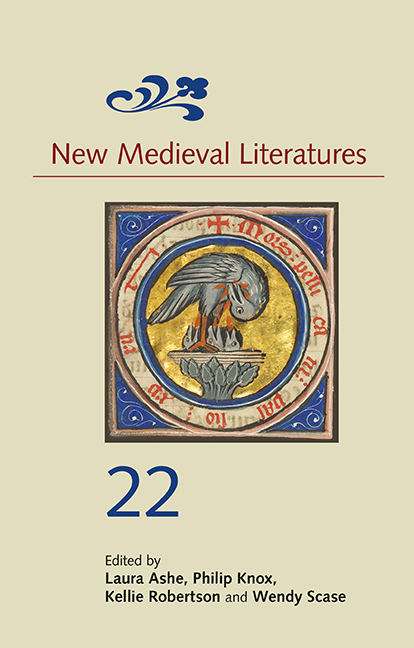Book contents
- Frontmatter
- Contents
- List of Illustrations
- List of Abbreviations
- 1 Touch and Movement in Chrétien de Troyes’s Chevalier de la Charrette
- 2 Cavernous Charisma: The Caves of the Patriarchs at Hebron
- 3 Lawman’s Vision of History: Sources and Figuration in the Brut
- 4 What the Mole Knows: Experience, Exempla, and Interspecies Dialogue in Albert the Great’s De animalibus
- 5 Demonic Prosthesis and the Walking Dead: The Materiality of Chaucer’s Green Yeoman
- 6 Learning to Live in Communities: Household Confession and Medieval Forms of Living
- 7 Alain Chartier’s Quadrilogue invectif and the Poetics of Political Community
- 8 Reginald Pecock’s moral philosophie, and Robert Holcot O.P.: Faith, Probabilism, and ‘Conscience’
- New Medieval Literatures Scholars of Colour Essay Prize
1 - Touch and Movement in Chrétien de Troyes’s Chevalier de la Charrette
Published online by Cambridge University Press: 26 May 2022
- Frontmatter
- Contents
- List of Illustrations
- List of Abbreviations
- 1 Touch and Movement in Chrétien de Troyes’s Chevalier de la Charrette
- 2 Cavernous Charisma: The Caves of the Patriarchs at Hebron
- 3 Lawman’s Vision of History: Sources and Figuration in the Brut
- 4 What the Mole Knows: Experience, Exempla, and Interspecies Dialogue in Albert the Great’s De animalibus
- 5 Demonic Prosthesis and the Walking Dead: The Materiality of Chaucer’s Green Yeoman
- 6 Learning to Live in Communities: Household Confession and Medieval Forms of Living
- 7 Alain Chartier’s Quadrilogue invectif and the Poetics of Political Community
- 8 Reginald Pecock’s moral philosophie, and Robert Holcot O.P.: Faith, Probabilism, and ‘Conscience’
- New Medieval Literatures Scholars of Colour Essay Prize
Summary
The Chevalier de la Charrette, it has long been recognised, is about delay – slow revelation, the postponement of meaning, the hiding of information about characters and their intents. This phenomenon owes a great deal to the elusive hero: not only does he famously hesitate to take a humiliating ride in the cart that gives him his nickname and the text its title, he is also repeatedly incognito, absent or paralysed either by indecision or love for Guinevere. Lancelot constitutes the ‘disappearing center’ of a narrative where many characters desire or quest for him. Contradictions accumulate around him, and he frequently experiences dilemmas before jumping to action. Both inscribed audiences and readers are led to ‘assess’ Lancelot – is he saviour or threat, good knight or bad? Lancelot's relationship with Guinevere also involves ambiguities, their eventual consummation shrouded in secrecy and misunderstanding, and both characters gesture towards, but ultimately avoid, the finality of martyrdom to love. More structurally, Lancelot's decisive face-off with Meleagant, tied to all possibility of justice, is long delayed, with several inconclusive fights. Eventually, Meleagant's defeat offers some closure, but the epilogue opens things up again, reawakening certain problems stemming from the opening (vague statements about authorship and patronage) and adding others (including the idea that a second author took over at an indeterminate point). Questions of interpretation and truth have therefore long dominated critical discussion, along with praise for the ‘art’ of the storyteller who wove this intriguing fabric.
I wish to argue that meaning in the Charrette is produced through contact between bodies. Narrative suspense is material and embodied, and the text's sophistication, I will contend, lies in its articulation of the physical as much as the psychological. The ‘art’ of the author manifests itself in the narration of battles, in a poetics of violence which has not been fully accounted for. I will therefore focus primarily on close reading the text's combat scenes, bringing out their evocation of a play of surfaces, including bodies (human, horse) and the objects that surround them (armour, lances, swords). Frequently, contact appears close, before being mediated, delayed, frustrated or inhibited.
- Type
- Chapter
- Information
- New Medieval Literatures 22 , pp. 1 - 30Publisher: Boydell & BrewerPrint publication year: 2022

